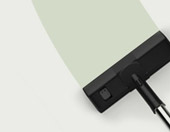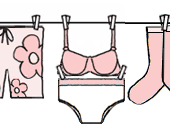When, Why and How Often Should Clothes Be Washed?
Posted in Healthy Home on October 30, 2015 by FloridaHealth.com staff. Last modified on December 02, 2018. Read disclaimer.
View text alternative for When to Wash Clothes infographic
floridahealth.com Infographic listing how often to wash clothes, bedding, towels and other laundryAdd this infographic to your website by copying and pasting the following embed code:
(Click in box to select all.)
+ Free Shipping & Returns on Eligible Items.
(*Amazon's Top 100 list updated hourly.)
Text alternative for "How Often Should You Wash Clothes?" infographic
Each of us sheds body fluids, oils, over 1 quart of sweat AND 500 million dead skin cells per day (yuck! that's 1.6 lbs. of dead skin per year), much of which ends up in our clothing, bedding and towels.1 Here, they're the perfect food for odor-producing and possible infection-spreading bacteria, fungus and more.
So, in order to stay healthy and non-smelly, how often should we wash items? Here are recommendations from the American Cleaning Institute2 and a dermatologist.3
(These guidelines assume you don't perspire more than normal or have open sores, athletes foot, etc., that the items aren't soiled by blood, food, dirt, etc., and don't smell sour. The guidelines also assume you don't share towels and that you hang garments and towels to dry between uses.)
Wash all newly purchased garments
Laws regarding commonly-used dyes, wrinkle-preventing formaldehyde resin, mold-preventing dimethyl fumarate (all of which are major allergens) and other chemicals vary between countries, which is of concern since few items of clothing are fully made in the U.S. Plus, that "new" garment may have been tried on (or bought and returned) by others prior to you purchasing it... spreading body secretions, feces, yeast, dead skin and other gross organisms.4
Regular laundry washing guidelines
Comforter and Pillows: wash twice a year.
Bedding and Bath Mat: wash every 2 weeks.
Loose-Fitting Items and Bath Towels: wash after 3-4 uses (e.g., dress clothes, pj's, jeans, sweaters).
Snug-to-the-Body Garments: wash after each use (e.g., t-shirts, underwear, socks, swimwear). Wash bras after every 2-3 wears.
Dandruff and other dead skin cells that we (and our pets) slough off also land in rugs and carpets so vacuuming regularly is another good idea!5
8 Examples of why clean laundry matters
While dirty laundry is often not a serious health issue until we get a cut or other skin abrasion, there are still plenty of reasons to wash clothes regularly. For instance, norovirus, a leading cause of diarrhea and vomiting, can live on clothes for up to 12 days!6 Other concerns include odor-causing bacteria, head lice, bed bugs, e. coli, ringworm, mold, fleas and everyday exposures (poison ivy, staph bacteria including MRSA, etc.).
7 Laundry Tips for cleaner clothes, saving money, and extending the life of machines.
1. Don't Overload the Washer or Dryer
Laundry needs to move freely in order for wash water to carry away dirt and
garments to dry quickly and wrinkle-free. (3/4th full is max).
2. Cold Water Works Great for Most Loads
In the old days, hot water made detergents work better. Today's detergents,
however, work perfectly well in 65 °F water, which is about what comes out
of the cold water faucet in most US homes (except in the some northern-most
areas)7. This is great news since heating water accounts for up to 90% of the cost
of washing clothes at home8! Plus, hot water can cause clothes to shrink. And even warm water may cause colors to fade. If garments are super dirty, presoak and spin them dry before washing. Cold water is always advised for the rinse cycle.
3. Empty Pockets
Don't trust that a drain filter will catch small items left in pockets. (Our top-of-the-line washer doesn't even have a drain filter, which resulted in a $300 service
call to remove a quarter and toothpick jammed in our washer's drain pump.)
4. Go Easy on Detergent
Using too much laundry detergent leaves dirty suds behind in the clothes, so they aren't as clean as they should be. Plus, excessive suds shortens the life of
your machine. Use only HE labeled laundry detergent in high-efficiency, front-loading washers and use no more than what's recommended on the detergent
bottle or box (but, in most cases, even that is too much). *Lid cup indicator lines are difficult to see so highlight them with a paint pen or buy pre measured, toss-in detergent pods.
5. Keep Washer Door or Lid Open Between Uses
The washer tub needs to dry between uses to prevent mold from growing and
rubber seals from rotting. So, always wipe rubber seals dry and keep door open.
6. Clean Dryer Line Filter After Each Use
A lint-filled filter makes the dryer work harder and takes more time and energy
to dry loads. Plus, it is a fire hazard.
7. Consider Drying Clothes Outside
Though not nearly as powerful as chlorine bleach, the oxidation that occurs when you dry clothes outdoors
in the sun sanitizes them better than if you put those clothes in the dryer.
And it's free! If you're an outdoors type, however, the heat of the dryer is perfect
for dehydrating and killing any ticks or fleas hiding in garments.
To learn more about staying health (plus, tips for preventing offensive body odor), visit FloridaHealth.com
Sources (accessed 10/30/2015):
1. https://www.youtube.com/watch?v=AuoqHdarSgc&feature=youtu.be
2. http://www.cleaninginstitute.org/clean_living/do_i_need_to_wash_this.aspx
3. http://www.wsj.com/articles/do-you-need-to-wash-new-clothes-before-wearing-them-1431955513
4. http://abcnews.go.com/GMA/gma-found-clothes-clean/story?id=9482373
5. http://www.sciencedaily.com/releases/2011/05/110509114034.htm
6. http://www.cdc.gov/hicpac/norovirus/tables/evidence-table-q3-ron.html
7. http://www.smithsonianmag.com/smart-news/case-washing-clothes-cold-water-180955459
8. https://www.floridahealth.com/clothes-washers-energy-efficiency.php
© copyright 2015. floridahealth.com



 Germiest items in your home | Quiz
Germiest items in your home | Quiz When to wash clothes | Infographic
When to wash clothes | Infographic How to select, ripen and enjoy healthy avocados
How to select, ripen and enjoy healthy avocados Potty training tips for girls and boys
Potty training tips for girls and boys Home & yard mosquito control | Infographic
Home & yard mosquito control | Infographic 9 Beauty secrets to younger-looking skin
9 Beauty secrets to younger-looking skin Dietary needs of adults and older adults
Dietary needs of adults and older adults Can cranberry juice prevent urinary tract infections?
Can cranberry juice prevent urinary tract infections? 9 Foods that are delicious and super nutritious
9 Foods that are delicious and super nutritious What works (and what doesn't) for hangovers
What works (and what doesn't) for hangovers Tips for preventing or treating sunburns
Tips for preventing or treating sunburns Foods that are high in calcium for healthy bones
Foods that are high in calcium for healthy bones Action plan for getting rid of cockroaches
Action plan for getting rid of cockroaches What causes body odor and how to prevent it
What causes body odor and how to prevent it Important tips for preventing heart disease
Important tips for preventing heart disease Ha! Try this funny technique for managing stress
Ha! Try this funny technique for managing stress How to prevent and remove mold and mildew
How to prevent and remove mold and mildew Container gardening ideas
Container gardening ideas What is cholesterol and tips for managing it
What is cholesterol and tips for managing it